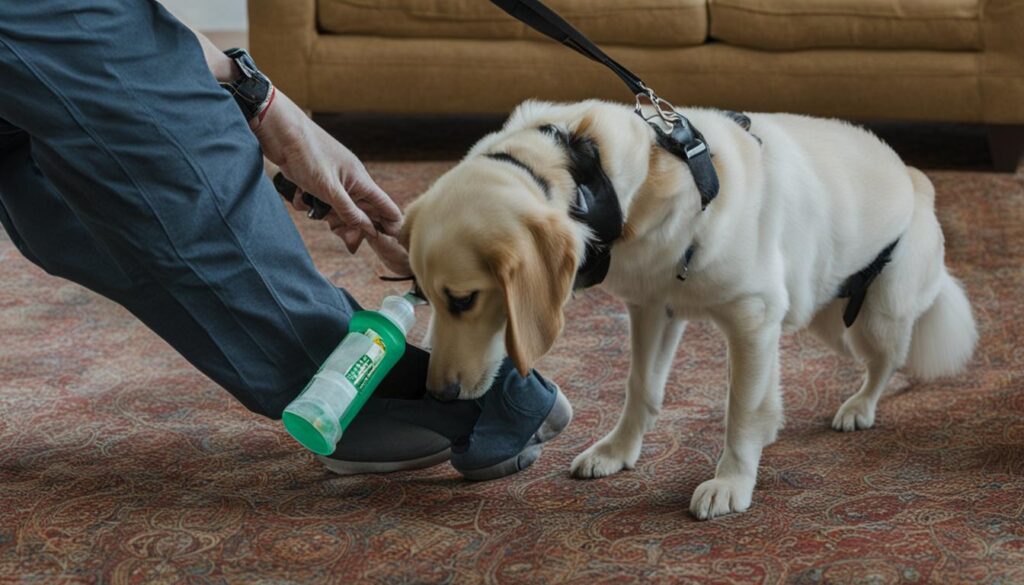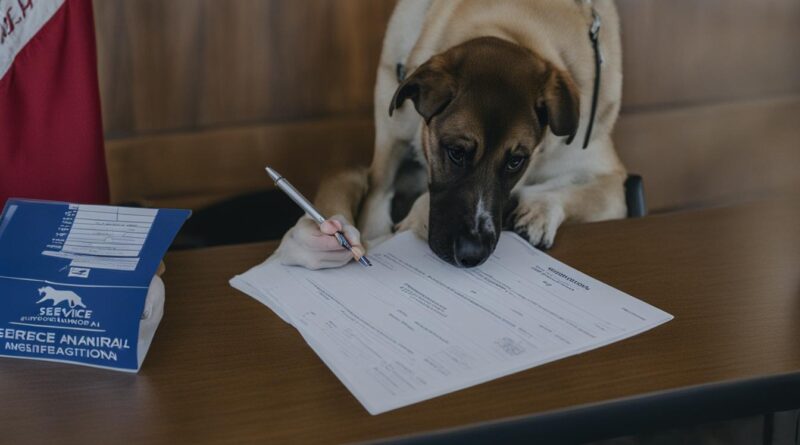Register Your Dog as a Service Animal Easily
Are you wondering how to get your dog registered as a service dog? Understanding the service dog registration process and the requirements involved can help you navigate this important step. Registering your dog as a service animal not only provides benefits for you and your furry companion but also ensures a smoother experience in public places.
Before diving into the registration process, it’s essential to note that registration is not a legal requirement. However, properly registering your service dog can help easily identify them as an assistance animal, potentially avoiding confrontations and misunderstandings.
To successfully register your dog as a service animal, there are several key steps to follow:
- Confirming a qualifying disability
- Training the service dog
- Optional service dog registration
By understanding the process and requirements involved, you can ensure that your dog is officially recognized as a service animal.
Key Takeaways
- Registering your dog as a service animal is not a legal requirement but can provide benefits.
- The process involves confirming a qualifying disability, training the dog, and optional registration.
- Qualifying disabilities are defined by the ADA and may vary by state.
- Service dogs require specific training to perform tasks related to the handler’s disability.
- Optional registration can make it easier to identify your service dog in public places.
Confirming a Qualifying Disability
To qualify for a service dog, an individual must have a physical or mental health impairment that substantially limits a major life activity. The Americans with Disabilities Act (ADA) defines disability as a physical or mental impairment that limits a major life activity such as work or socializing. In California, the definition of disability is less strict, stating that it is a mental or physical impairment that limits a significant life activity. A licensed healthcare professional can assess the individual’s condition and provide documentation, such as a psychiatric service dog (PSD) letter, for psychiatric issues.
Qualifying for a service dog involves meeting specific criteria that establish a genuine need for assistance. The ADA sets the standard for disability eligibility in the United States, while individual states may have additional guidelines. Let’s take a closer look at the definition of disability according to the ADA and the specific standards set in California.
“Disability is a physical or mental impairment that limits a major life activity.”
– Americans with Disabilities Act (ADA)
The ADA provides a broad definition of disability, emphasizing that it includes both physical and mental impairments. This means that individuals with conditions such as mobility limitations, visual impairments, hearing loss, chronic pain, or mental health disorders may qualify for a service dog. The disability must substantially limit a major life activity, which can range from performing manual tasks to engaging in social interactions or participating in work or educational activities.
In California, the definition of disability is slightly different. The state recognizes disability as a mental or physical impairment that limits a significant life activity. While the California definition is more inclusive, it is important to note that it is less strict than the ADA’s definition. Therefore, individuals who may not meet the ADA’s requirements may still qualify for a service dog in California.
Here’s an example of how a psychiatric service dog can provide assistance to an individual with a mental health impairment:
| Disability | Tasks Performed by the Service Dog |
|---|---|
| Post-Traumatic Stress Disorder (PTSD) | Providing grounding during anxiety attacks, interrupting panic episodes, waking up the handler during nightmares, creating physical barriers in crowded places, offering emotional support in public settings |
It is crucial to consult with a licensed healthcare professional who can assess your condition and provide appropriate documentation. For individuals with psychiatric conditions, a psychiatric service dog (PSD) letter from a mental health professional may be required to confirm the qualifying disability.
By confirming a qualifying disability, individuals can navigate the process of obtaining a service dog with clarity and confidence. With the necessary documentation in hand, they can proceed to the next step: training the service dog to perform tasks related to their specific disability.
Training the Service Dog
A service dog plays a crucial role in assisting individuals with disabilities, and its effectiveness relies on comprehensive training. Through tailored training programs, service dogs become proficient in carrying out tasks specific to the handler’s disability, enabling them to live a more independent and fulfilling life.
Training a service dog entails teaching it a range of tasks that address the handler’s unique needs and challenges. These tasks can vary based on the type of disability but often include:
- Opening doors and cabinets
- Retrieving objects
- Assisting during emergencies
- Guiding the handler through crowded spaces or traffic
- Providing comfort and pressure therapy during mental health crises
By mastering these tasks, service dogs become invaluable companions, offering practical assistance and support at all times.
In addition to task-specific training, service dogs must undergo public access training. This type of training ensures that dogs exhibit proper behavior and are well-behaved in various public settings, such as restaurants, stores, and transportation hubs. Public access training focuses on:
- Reinforcing obedience commands
- Ensuring the dog remains calm and composed in crowded areas
- Practicing appropriate interactions with people and other animals
- Teaching the dog to stay focused on the handler’s needs
This training plays a vital role in ensuring that service dogs can accompany their handlers in public spaces without causing disruptions or posing risks to others. It enables service dogs to provide their valuable assistance while maintaining a high level of social etiquette.
Public access training ensures that service dogs can navigate public spaces effectively and without causing disturbances, allowing individuals with disabilities to go about their daily lives with greater independence and confidence.
Through rigorous and specialized training in both task performance and public access, service dogs are equipped with the skills needed to fulfill their vital role as reliable and supportive partners to individuals with disabilities.

Optional Service Dog Registration
Although not legally required, some service dog handlers choose to register their dogs with service dog certification organizations. Registering a service dog involves entering the dog’s information into a searchable database, which can be linked to an ID card or other identifiers. These identifiers can help signal to the public that the dog is an assistance animal and avoid unnecessary confrontations. While registration provides convenience and peace of mind, it should not be done until the dog has fully qualified as a service animal.
Conclusion
The process of registering a dog as a service animal involves several important steps. First, it is essential to confirm a qualifying disability, which can be done through documentation provided by a licensed healthcare professional. Next, the dog must undergo training to perform tasks specific to the handler’s disability. This training ensures that the dog can actively assist the handler in their daily activities.
While registering a service dog is not a legal requirement, it can offer significant benefits. In public places, such as stores, restaurants, or public transportation, registration can help easily identify the dog as an assistance animal. This identification can lead to smoother interactions and reduce the likelihood of confrontations with individuals who may not be aware of the dog’s purpose.
Optional service dog registration is available through various service dog certification organizations. This process involves entering the dog’s information into a searchable database, enabling the dog to be easily recognized as a service animal. However, it is important to note that registration should only be pursued once the dog has fully qualified as a service animal through the required training and meets all necessary criteria.
In conclusion, while service dog registration is not mandatory, it can provide valuable benefits to handlers and their canine companions. By confirming a qualifying disability, training the dog to perform specific tasks, and considering optional registration, service dog handlers can navigate public spaces with confidence, knowing that their assistance animal is recognized and respected.
FAQ
How do I get my dog registered as a service dog?
To register your dog as a service dog, you need to confirm that you have a qualifying disability, train the dog to perform tasks related to your disability, and optionally register the dog with a service dog certification organization.
What is a qualifying disability for a service dog?
A qualifying disability is a physical or mental health impairment that substantially limits a major life activity. The definition of disability may vary depending on the state and the Americans with Disabilities Act (ADA) guidelines.
What tasks does a service dog need to be trained to perform?
The tasks a service dog needs to be trained to perform depend on the handler’s disability. They may include opening doors, retrieving items, guiding the handler, responding to emergencies, or providing support during mental health crises.
What is public access training for service dogs?
Public access training is necessary to ensure that the service dog can behave well in public environments. This training prepares the dog to be well-behaved and under the handler’s control at all times.
Is registering a service dog required by law?
No, registering a service dog is not a legal requirement. However, some handlers choose to register their dogs with service dog certification organizations to easily identify them as assistance animals and avoid confrontations in public places.


